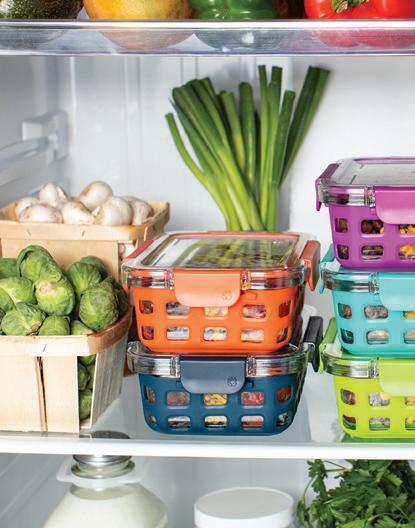
4 minute read
How to Build a Healthy, Balanced Menu
Let’s talk about weekly meal prep and how it can help foster a healthy lifestyle.
By: Coach Kati Epps
Building a weekly menu can save you time and money, and help plan for living a healthy-eating lifestyle. Depending on your nutrition goals, creating a meal plan can be a solid foundation as you work toward those goals. But what does this look like? Staring in the face of having to create seven different days of four to six meals/snacks per day can look like a daunting task and cause you to get overwhelmed — quickly.
If the process seems crushing, break it up into a few simple steps.
1. Evaluate Your Lifestyle
Are you up at 5:30 a.m. or not until 7 a.m.? Do you rush out the door to get to work or take your children to school, then you’re away for the rest of the day? Are you home most of the day and have a lot of access to the kitchen? This will determine if you need easy and quick meals that travel well or if you can have meals prepped and ready for assembly in your fridge.
Pro Tip: Analyze your week on Sundays and look for early meetings, late nights or potential cliententertaining at restaurants.
2. Consider Your Energy Expenditure
When do you work out? How much are you active at your job? Are you constantly on the move? If you train early, do you prefer to eat before or after? If you train in the afternoon, what do you need from your nutrition to give yourself the right fuel for an incredible workout? This will determine what you eat and when you eat it.
Pro Tip: Sign up for your classes or schedule them with a partner at the beginning of the week so you have accountability and a clear picture of when you will be training.
3. Think About The Food
What do you like to eat? Do you need a different menu every day, or do you prefer to eat the same things over and over? This will determine how much preparation you will need at the beginning of the week.
Pro Tip: If you like food variety but need convenience, find two to three meals or snacks that you like and do not mind eating multiple times per week, and save your variety meals for lunch or dinner.
Once you have a good idea of what your week looks like and what kind of foods you want to eat for the week, it is time to balance your day’s food. The easiest is to either have a calorie goal, a macronutrient goal or a portion goal.
Pro Tip: Calculating calories and macronutrients should be done when creating the menu. It is easier to see where and when calories or macronutrients are consumed if you know before you eat. This will keep you from over- or under-eating. Both can be detrimental to your goals.
Many people work very well eating four to five times per day. This is usually breakfast, morning snack, lunch, afternoon snack and dinner. However, some may skip the morning snack in favor of an after-dinner snack. Each meal should have some form of protein, some form of carbohydrate and maybe a bit of healthy fat. Think about your plate in terms of a pie. Half of your pie is carbohydrates (not cookies and cakes, but fruits, vegetables and grains), a quarter is protein and the last quarter is healthy fat.
Pro Tip: If you are using a food-tracking app, you can set your calorie and macronutrient goals, then enter your menu to see how you measure up to those goals with your food choices.
No matter how you choose to track your food, making a plan will be the foundation for healthyeating success. Building a menu at the beginning of the week will set you up for planning your workouts, ease your grocery bill and put an end to the ever-annoying question, “What’s for dinner?” Cheers and happy healthy eating! afm
Now to build the plan!
Breakfast:
Protein: 3 egg whites
Carbohydrate: 1 cup spinach, 1 small orange, 1 slice toast
Fat: 1 oz avocado
Morning Snack:
Protein: low-fat Greek yogurt
Carbohydrate: ¼ cup low-fat granola, 2 strawberries
Fat: 1 tbsp almond slivers
Lunch:
Protein: 4 oz chicken breast
Carbohydrate: 1 cup broccoli, ¾ cup brown rice
Fat: 1 tsp olive oil for cooking
Afternoon Snack:
Protein: 2 oz turkey deli meat
Carbohydrate: 4 cucumber slices, 4 carrot sticks, 4 celery sticks, 4 bell pepper slices
Fat: 2 tbsp hummus
Dinner:
Protein: 4 oz shrimp
Carbohydrate: 2 oz angel hair pasta, ½ cup marinara sauce, 6 spears of asparagus, side salad
Fat: 1 tsp olive oil for cooking, 1 tsp avocado oil for salad dressing
If you do not have a food scale or you are eating in a restaurant, a good way to watch your portions is to use the HAND method:
Protein is the size of the palm of your hand.
Vegetables are the size of your hand open, fingers spread.
Root vegetables and grains are the size of your hand in a fist.
Fat is about the size of your thumb to the first knuckle.
Coach Kati Epps is the founder of MyBody GX with a background in chemistry from Colorado State University and is an ACE-certified personal trainer, health coach and nutrition specialist.










